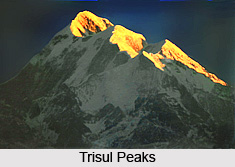 Trisul Peaks are a group of three Himalayan Mountain peaks that lie in the western Kumaun of Uttarakhand. Trisul is named after the trident of Lord Shiva. The term "Trident" in Hindi or Sanskrit means "Trishula". It is the weapon of Shiva. The main peak, Trisul I, is best known for being the first peak over 7,000 m (22,970 ft) to have ever been climbed, in 1907. The three peaks of Trisul Peaks are named as Trisul I, Trisul II, and Trisul III.
Trisul Peaks are a group of three Himalayan Mountain peaks that lie in the western Kumaun of Uttarakhand. Trisul is named after the trident of Lord Shiva. The term "Trident" in Hindi or Sanskrit means "Trishula". It is the weapon of Shiva. The main peak, Trisul I, is best known for being the first peak over 7,000 m (22,970 ft) to have ever been climbed, in 1907. The three peaks of Trisul Peaks are named as Trisul I, Trisul II, and Trisul III.
Location of Trisul Peaks
The peaks are situated in the central part of Uttarakhand state of India. The Trisul Peaks are clustered near the Bageshwar district. They form the southeast corner of the ring of peaks enclosing the Nanda Devi Sanctuary, and are located at the west-southwest of Nanda Devi itself at a distance of about 15 kilometres (9 mi). The massif is a north-south ridge with Trisul I lying at the north end and Trisul III at the south.
Climbing History of Trisul Peaks
Trisul is best viewed from Kausani and Bedini Bugyal. Nanda Ghunti is situated a few kilometres to the northwest, while Mrigthuni lies just to the southeast. Routes on the west face and south ridge of Trisul I have been climbed. The west face was first ascended in 1976; this was the first climb of the main summit not using the first-ascent route. Trisul II and III were first climbed in 1960 by a Yugoslav team. They climbed from the Bidalgwar glacier, thus achieving the summit of Trisul II through the southern ridge and Trisul III via the north ridge. Another Yugoslav expedition made the first traverse of the three peaks in 1987, and two of the members` paraglided from the summit of Trisul Peaks. Alex Kunaver was a member of the first Yugoslav team who climbed Trisul Peaks in 1960. In 1987, his daughter Vlasta Kunaver also climbed Trisul I and was one of the renowned paragliders.
Connectivity of Trisul Peaks
The Trisul Peaks can be accessed through the following routes, namely Almora, Kausani, Garur, Gwaldam, Debal, Bagargad, Wan, Bedini Bugyal, Kelva Vinayak, Roopkund and Trisul.















